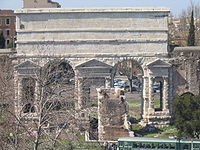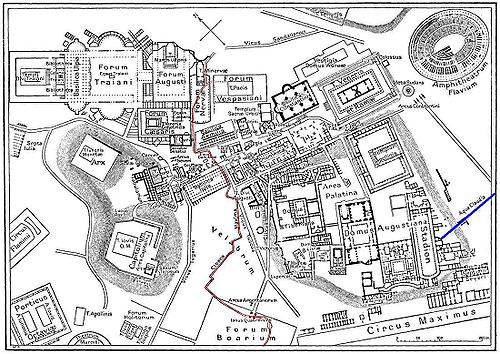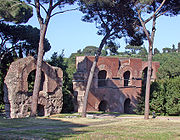
De aquaeductu
Encyclopedia
is a two-book official report given to the emperor on the state of the aqueducts of Rome
, and was written by Julius Sextus Frontinus at the end of the 1st century AD. It is also known as or . It is the earliest official report of an investigation made by a distinguished citizen on Roman engineering
works to have survived. Frontinus had been appointed Water Commissioner by the emperor Nerva
in 95 AD.
 The work presents a history and description of the water-supply of Rome, including the laws relating to its use and maintenance. He describes the history of all of the nine aqueducts of Rome
The work presents a history and description of the water-supply of Rome, including the laws relating to its use and maintenance. He describes the history of all of the nine aqueducts of Rome
at the time at which he was writing at the turn of the 1st century AD. The aqueducts included Aqua Marcia
, Aqua Appia
, Aqua Alsietina
, Aqua Tepula
, Anio Novus
, Aqua Virgo
, and Aqua Claudia
. They are described with details of the sizes of the channels and discharge rates. Frontinus describes the quality of water delivered by each, mainly depending on their source, be it river, lake, or spring.
 One of the first jobs he undertook when appointed water commissioner was to prepare maps of the system so that he could assess their condition before undertaking their maintenance. He says that many had been neglected and were not working at their full capacity. He was especially concerned by diversion of the supply by unscrupulous farmers, tradesmen, and domestic users, among others. They would insert pipes into the channel of the aqueducts to tap the supply without official approval, or insert pipes of larger diameter than approved. Roman lead pipe inscription
One of the first jobs he undertook when appointed water commissioner was to prepare maps of the system so that he could assess their condition before undertaking their maintenance. He says that many had been neglected and were not working at their full capacity. He was especially concerned by diversion of the supply by unscrupulous farmers, tradesmen, and domestic users, among others. They would insert pipes into the channel of the aqueducts to tap the supply without official approval, or insert pipes of larger diameter than approved. Roman lead pipe inscription
s bearing the name of the owner were meant to prevent such water theft.
He, therefore, made a meticulous survey of the intake and the supply of each line, and then investigated the apparent discrepancies. His assessment was based on the cross-sectional area of the pipes or channels, and he did not take water velocity into consideration.
He was well aware of the seminal work De Architectura
by Vitruvius
, which mentions aqueduct
construction and maintenance of the channels, published in the previous century, classing him at one point with "the plumbers".


Waste water would end up primarily in the main sewers, which led into the Cloaca Maxima
and finally the river Tiber
. The continuous flow of water ensured that the sewers were kept clear and free of obstructions, so contributing to the hygiene of the city.
, and numerous settling tanks (each one being known as a castellum
) were built along their lengths. They also served as convenient distribution points in the city itself, where the supply was split to feed different uses.
He reviewed the existing law governing the state aqueducts, as well as the need for enforcement of those statute
s.
Aqueducts of Rome
This is a list of aqueducts in Rome listed in chronological order of their construction.- Ancient Rome :* Aqua Appia** built in 312 BC** source: springs to the east of Rome...
, and was written by Julius Sextus Frontinus at the end of the 1st century AD. It is also known as or . It is the earliest official report of an investigation made by a distinguished citizen on Roman engineering
Roman engineering
Romans are famous for their advanced engineering accomplishments, although some of their own inventions were improvements on older ideas, concepts and inventions. Technology for bringing running water into cities was developed in the east, but transformed by the Romans into a technology...
works to have survived. Frontinus had been appointed Water Commissioner by the emperor Nerva
Nerva
Nerva , was Roman Emperor from 96 to 98. Nerva became Emperor at the age of sixty-five, after a lifetime of imperial service under Nero and the rulers of the Flavian dynasty. Under Nero, he was a member of the imperial entourage and played a vital part in exposing the Pisonian conspiracy of 65...
in 95 AD.
Water supply of Rome

Aqueducts of Rome
This is a list of aqueducts in Rome listed in chronological order of their construction.- Ancient Rome :* Aqua Appia** built in 312 BC** source: springs to the east of Rome...
at the time at which he was writing at the turn of the 1st century AD. The aqueducts included Aqua Marcia
Aqua Marcia
The Aqua Marcia was the longest of the 11 aqueducts that supplied the city of ancient Rome. The still-functioning Acqua Felice from 1586 runs on long stretches along the route of the Aqua Marcia....
, Aqua Appia
Aqua Appia
The Aqua Appia was the first Roman aqueduct. It was constructed in 312 BC by Appius Claudius Caecus, the same Roman censor who also built the important Via Appia...
, Aqua Alsietina
Aqua Alsietina
In Ancient Rome, the Aqua Alsietina was the earliest of the two western aqueducts, erected somewhere around 2 BC, during the reign of emperor Augustus...
, Aqua Tepula
Aqua Tepula
The Aqua Tepula is an ancient Roman aqueduct built in 126 BC by censors G. Servilius Caepio and L. Cassius Longinus. Its source was at the Alban hills, running only a mere 18 kilometers to Rome...
, Anio Novus
Anio Novus
Anio Novus is an aqueduct of Rome. Together with the Aqua Claudia, it was begun by emperor Caligula in 38 AD and completed in 52 AD by Claudius, who dedicated them both on August 1.-Details:...
, Aqua Virgo
Aqua Virgo
The Aqua Virgo was one of the 11 aqueducts that supplied the city of ancient Rome. The aqueduct fell into disuse with the fall of the Roman Empire, but was fully restored nearly a whole millennium later during the Renaissance to take its current form as the Acqua Vergine.The Aqua Virgo was...
, and Aqua Claudia
Aqua Claudia
Aqua Claudia was an aqueduct of ancient Rome that, like the Anio Novus, was begun by emperor Caligula in 38 AD and completed by Emperor Claudius in 52 AD. Its main springs, the Caeruleus and Curtius, were situated 300 paces to the left of the thirty-eighth milestone of the Via Sublacensis...
. They are described with details of the sizes of the channels and discharge rates. Frontinus describes the quality of water delivered by each, mainly depending on their source, be it river, lake, or spring.

Roman lead pipe inscription
A Roman lead pipe inscription is a Latin inscription on a Roman water pipe made of lead which provides brief information on its manufacturer and owner, often the reigning emperor himself as the supreme authority...
s bearing the name of the owner were meant to prevent such water theft.
He, therefore, made a meticulous survey of the intake and the supply of each line, and then investigated the apparent discrepancies. His assessment was based on the cross-sectional area of the pipes or channels, and he did not take water velocity into consideration.
He was well aware of the seminal work De Architectura
De architectura
' is a treatise on architecture written by the Roman architect Vitruvius and dedicated to his patron, the emperor Caesar Augustus, as a guide for building projects...
by Vitruvius
Vitruvius
Marcus Vitruvius Pollio was a Roman writer, architect and engineer, active in the 1st century BC. He is best known as the author of the multi-volume work De Architectura ....
, which mentions aqueduct
Aqueduct
An aqueduct is a water supply or navigable channel constructed to convey water. In modern engineering, the term is used for any system of pipes, ditches, canals, tunnels, and other structures used for this purpose....
construction and maintenance of the channels, published in the previous century, classing him at one point with "the plumbers".


Distribution system
Distribution of the water depended in a complex way on its height entering the city, the quality of the water, and its rate of discharge. Thus, poor-quality water would be sent for irrigation, gardens, or flushing, while only the best would be reserved for potable use. Intermediate-quality water would be used for the many baths and fountains. However, Frontinus criticises the practice of mixing supplies from different sources, and one of his first decisions was to separate the waters from each system.Waste water would end up primarily in the main sewers, which led into the Cloaca Maxima
Cloaca Maxima
The Cloaca Maxima is one of the world's earliest sewage systems. Constructed in Ancient Rome in order to drain local marshes and remove the waste of one of the world's most populous cities, it carried an effluent to the River Tiber, which ran beside the city....
and finally the river Tiber
Tiber
The Tiber is the third-longest river in Italy, rising in the Apennine Mountains in Emilia-Romagna and flowing through Umbria and Lazio to the Tyrrhenian Sea. It drains a basin estimated at...
. The continuous flow of water ensured that the sewers were kept clear and free of obstructions, so contributing to the hygiene of the city.
Maintenance
He was very concerned by leaks in the system, especially those in the underground conduits, which were difficult to locate and mend, a problem still faced by water engineers today. The aqueducts above ground needed care to ensure that the masonry was kept in good condition, especially those running on arched superstructures. They were mainly those aqueducts approaching Rome from the east over the plains of the Roman Campagna. It was, he said, essential to keep trees at a distance so that their roots would not damage the structures. Silting of the channels was another common problem, especially those aqueducts that drew water directly from rivers, such as Anio NovusAnio Novus
Anio Novus is an aqueduct of Rome. Together with the Aqua Claudia, it was begun by emperor Caligula in 38 AD and completed in 52 AD by Claudius, who dedicated them both on August 1.-Details:...
, and numerous settling tanks (each one being known as a castellum
Castellum
A castellum is a small Roman detached fort or fortlet used as a watch tower or signal station. The Latin word castellum is a diminutive of castra , which in turn is the plural of castrum ; it is the source of the English word "castle".The term castellum was also used to refer to a settling or...
) were built along their lengths. They also served as convenient distribution points in the city itself, where the supply was split to feed different uses.
He reviewed the existing law governing the state aqueducts, as well as the need for enforcement of those statute
Statute
A statute is a formal written enactment of a legislative authority that governs a state, city, or county. Typically, statutes command or prohibit something, or declare policy. The word is often used to distinguish law made by legislative bodies from case law, decided by courts, and regulations...
s.
See also
- Aqueducts
- List of Roman aqueduct bridges
- Roman architectureRoman architectureAncient Roman architecture adopted certain aspects of Ancient Greek architecture, creating a new architectural style. The Romans were indebted to their Etruscan neighbors and forefathers who supplied them with a wealth of knowledge essential for future architectural solutions, such as hydraulics...
- Roman engineeringRoman engineeringRomans are famous for their advanced engineering accomplishments, although some of their own inventions were improvements on older ideas, concepts and inventions. Technology for bringing running water into cities was developed in the east, but transformed by the Romans into a technology...
- VitruviusVitruviusMarcus Vitruvius Pollio was a Roman writer, architect and engineer, active in the 1st century BC. He is best known as the author of the multi-volume work De Architectura ....
- De ArchitecturaDe architectura' is a treatise on architecture written by the Roman architect Vitruvius and dedicated to his patron, the emperor Caesar Augustus, as a guide for building projects...
External links
- Frontinus at LacusCurtius: full texts of De aquis and Strategemata in Latin and English; illustrated with some of the Monscassinensis manuscript from the Herschel edition.
- Sextus Iulius Frontinus (fr)
- Models of Various Aqueducts of Ancient Rome
- Routes of Various Aqueducts of Ancient Rome
- Famous Fountains of Rome
- The Fountains of Rome (by Region)
- Spanish site dedicated to Roman technology, especially aqueducts and mines

